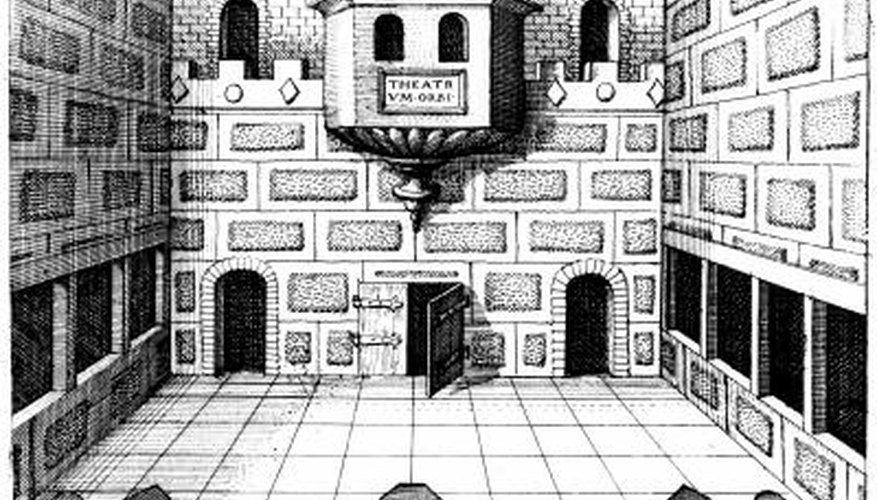The playing space of a thrust stage juts or "thrusts" out into the audience. This distinguishes it from a proscenium stage, which is located at one end of the theatre with all audience facing it head on. Thrust playing spaces were the traditional configuration of the Elizabethan theatre and afforded great intimacy between actors and audience, the need for very little scenery and gave the audience a three-dimensional view of the action.
Actor/Audience Intimacy
Perhaps the greatest advantage provided by a thrust stage is the proximity between actors and audience. The action of the play set on a thrust stage moves forward into the audience, not back and forth in front of it. In this stage configuration, the audience can even feel as though it is included in the action on the stage. Not only are the actors close to and moving between the audience, the audience itself is seated so that it can observe those audience members seated directly across the stage. In this way, enjoying other audience members as they enjoy the play is an added aspect of the performance.
- Perhaps the greatest advantage provided by a thrust stage is the proximity between actors and audience.
- Not only are the actors close to and moving between the audience, the audience itself is seated so that it can observe those audience members seated directly across the stage.
Less Scenery
Theatre is an art form that has traditionally relied on the imagination of the audience to create the time and place of the action. However, over the centuries, scenery has come to play a more and more important role in creating the play's location. The thrust stage is not conducive to much scenery, since the sight lines from audience on one side or the other would be blocked by placements anywhere but the extreme upstage location. Because of this, plays staged on a thrust must go "old school" and rely on the imagination of the audience and the use of minimal set pieces. This benefits not only the imaginative quality of the performance but reduces the cost of staging a play, as well.
- Theatre is an art form that has traditionally relied on the imagination of the audience to create the time and place of the action.
- Because of this, plays staged on a thrust must go "old school" and rely on the imagination of the audience and the use of minimal set pieces.
3-D Effect
Instead of viewing the action from a flattened-out perspective, audience members attending a performance on a thrust stage watch the action in three dimensions. Actors walk past the audience, sometimes entering and exiting from among the crowd. This 3-D relationship between actor and audience heightens the naturalness of the presentation. Actors aren't standing side-by-side, slightly "turned out," so that they can be seen having an intimate conversation, as they would be on a proscenium. On a thrust stage, actors are able to face each other directly. And since the performance is seen from three different angles, each audience member is seeing a slightly "different" play, depending on which side of the stage he is sitting.
- Instead of viewing the action from a flattened-out perspective, audience members attending a performance on a thrust stage watch the action in three dimensions.
Staging Shakespeare's Plays
William Shakespeare staged his plays on a thrust stage in the Globe with the full intention that the audience would be in close proximity to the action, have the advantage of a three-dimensional view of the performance and be required to use its imagination to conjure each scene's setting. Theatre companies such as the Royal Shakespeare Company advocate the use of thrust stages for presenting Shakespeare's plays so that modern audiences can have the experience of intimate interaction with the actors in the manner Shakespeare intended his plays to be performed.
